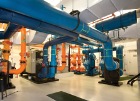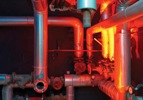
Gas Detection for Your Building's Mechanical System
Gas monitoring for the entire system is critical, not only for compliance reasons, but also for protecting your people and operation.
Is your building's mechanical system complete? Do you have gas detection for both your boiler and your chiller equipment? Does it comply with the necessary codes and protect your building's people and operation?
 A building's mechanical system is the hub of its heating, ventilation, and air conditioning system. This can include central utility plants, boiler and chiller rooms, mechanical and electrical rooms, and fuel rooms. The equipment within these rooms has the potential to leak harmful combustible or toxic gases, including costly, environmentally harmful refrigerant gases. These gases are potentially dangerous and can undermine safety if leaks occur. Monitoring all of the gas hazards surrounding this one mechanical system allows building owners to be more confident in the total operation of their mechanical system.
A building's mechanical system is the hub of its heating, ventilation, and air conditioning system. This can include central utility plants, boiler and chiller rooms, mechanical and electrical rooms, and fuel rooms. The equipment within these rooms has the potential to leak harmful combustible or toxic gases, including costly, environmentally harmful refrigerant gases. These gases are potentially dangerous and can undermine safety if leaks occur. Monitoring all of the gas hazards surrounding this one mechanical system allows building owners to be more confident in the total operation of their mechanical system.
The boiler and chiller equipment comprising a building's mechanical system can be located in the same room, or it can be located in different spaces. No matter the set-up, achieving compliance with ASHRAE 15, the International Building Code, or CSA-B52 is critical. Equally important is preventing damages caused by undetected leaks, such as explosive risks leading to structural damage, loss of life, or an expensive waste of fuel. The presence of a complete gas monitoring system can help mitigate these risks.
Boiler Equipment
When your boiler equipment is in a room separate from your chiller equipment, it is often visited infrequently, increasing the risk of a toxic or combustible leak's going unnoticed and undetected. An automatic gas detection system will provide early warning of gas release during these unmanned periods.
Natural gas -- primarily methane -- is one of the most widely used fuels for heating commercial and industrial property. Methane is approximately half the weight of air and will rise toward the ceiling or roof space of a plant room. The minimum gas concentration in air that will generate an explosion -- if ignited -- is the Lower Flammable Limit, which is 4.4 percent by volume for methane. Potential sources of ignition can include any uncertified electrical equipment, including lighting, switches, control panels, and more. Though it is non-toxic, the flammability of methane makes your boiler room or equipment highly dangerous if not monitored and controlled properly.
When it comes to boiler equipment rooms, ventilation is the first thing to consider when it comes to installation. The key objective for ventilation surrounding a building's boiler equipment is to ensure an adequate supply of fresh air. Proper ventilation can also help reduce the buildup of combustible gases, but ventilation alone is not enough to guarantee safety. Boiler equipment also emits toxic gases, which is why gas detection systems in this area are so valuable to the protection of people and property.
A gas detection system is comprised of a number of strategically located sensors that set off audible and visual alarms upon the detection of certain gas. They can be stand-alone detection systems or networkable, with the ability to interface with a building's existing Building Automation System (BAS).
The location of gas sensors is another thing to consider when installing a gas detection system. Gas sensors should be located close to where the leak might occur, as shown in Figure 1.
Carbon Monoxide Poisoning
One of the biggest toxic gas concerns for boiler equipment is carbon monoxide (CO). If a leak occurs, the effects can be equivalent to sitting in your closed garage with the car running, yielding potentially deadly results. At first, you'll get a headache, feel dizzy and weak, and maybe nauseous. That progresses to vomiting, chest pain, confusion, and at high levels of inhalation, loss of consciousness and death.
The same thing can happen if a carbon monoxide leak occurs in a boiler room. For healthy adults, CO becomes toxic when it reaches a level higher than 50 ppm with continuous exposure over an eight-hour period. According to the Centers for Disease Control and Prevention, each year, more than 400 Americans die from unintentional CO poisoning, more than 20,000 visit an emergency room, and more than 4,000 are hospitalized due to CO poisoning. A simple gas detection system for your boiler equipment can easily prevent the problem when it comes to a building's mechanical room.
Chiller Equipment
Now that we've seen the advantages of installing gas detection for your building's boiler equipment, we'll complete a building's mechanical system and talk about the chiller equipment. Installing refrigerant gas monitors is paramount when it comes to mechanical equipment. They provide early detection to help prevent significant refrigerant loss in the case of a leak, they satisfy the requirements for equipment room emissions included in EPA regulations, and, most importantly, they limit the exposure of workers to refrigerant leaks for increased safety. Additionally, refrigerant gas monitors help you achieve compliance with ASHRAE 15, CSA-B52, and the International Building Code.
According to ASHRAE Standard 15-2007, each machinery room must contain a detector located where a refrigerant leak would concentrate. As shown in Figure 2, a refrigerant gas sensor is positioned near each piece of chiller equipment that could potentially leak and cause a hazard.
Diffusion and Sample-Draw Systems
When determining the type of gas monitoring system to use, building owners have the option between diffusion systems and sample-draw systems. Diffusion systems monitor the air quality continuously, in real time, allowing for quicker leak detection. There are no pumps to replace or tubes to get clogged or punctured. The daisy chain wiring design of diffusion monitors adds to the ease of installation and also results in lower maintenance time and cost. These systems can be stand-alone monitors (single point, for smaller applications) or networkable systems (multiple sensing points, usually in large applications).
Sample-draw systems, on the other hand, typically include multiple sampling points, sequential (rather than real-time) readings, several programmable outputs, and pumps and solenoids to move multiple samples. These systems are most often used when low cost per point is the top priority to a building owner. One drawback is that maintenance costs could be higher.
The Cost of Refrigerant Leaks
Refrigerant leaks are not only a risk to personal safety, but they are also a significant maintenance expense for organizations using or maintaining refrigerant gas. With some refrigerant gases costing about $10 to $15 per pound, early leak detection can minimize replacement costs.
For example, if a supermarket chain uses 400,000 pounds of refrigerant and has an annual leak rate of 5 percent, this amounts to $200,000 of cost in lost refrigerant that must be replaced each year. Early detection of these leaks can save thousands of dollars in refrigerant cost annually. EPA also imposes fines based on the amount of refrigerant purchased in a given year, operating under the assumption that refrigerant is being purchased because it has leaked from your system into the atmosphere.
Regulation is increasing, and EPA fines are now up to $37,500 per day for anyone venting ozone-depleting gases at a 37.5 percent leak rate. This can all be avoided with a reliable gas detection system, and ASHRAE Standards 15 and 34 are helping regulate refrigerant concentration.
Gas monitoring for your building's entire mechanical system is critical, not only for compliance reasons, but also for protecting your people and operation. Early leak detection for toxic, combustible, and refrigerant gases helps mitigate detrimental and potentially costly outcomes. When it comes to your building's mechanical system, make sure it's complete by including all necessary gas monitoring equipment and covering all of the bases.
This article originally appeared in the May 2011 issue of Occupational Health & Safety.
About the Author
Kimberly Fletcher ([email protected]) is a Marketing Communications Specialist at Honeywell Analytics (www.honeywellanalytics.com)